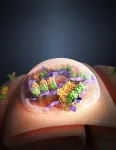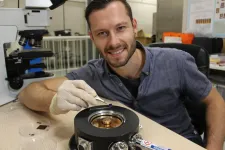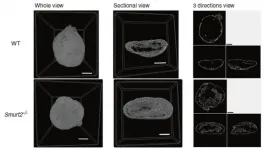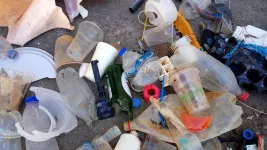INFORMATION:
Ophiura from Russky Island might make photodynamic therapy more affordable
2021-02-08
(Press-News.org) An unusual biologically active porphyrin compound was isolated from seabed dweller Ophiura sarsii. The substance might be used as an affordable light-sensitive drug for innovative photodynamic therapy and for targeted treatment of triple-negative breast cancer and some other cancers. Researchers from the School of Biomedicine of Far Eastern Federal University (FEFU) and the University of Geneva reported the findings in Marine Drugs.
The seabed dweller Ophiura sarsii, the source of the new compound, was isolated at a depth of 15-18 meters in Bogdanovich Bay, Russky Island (Vladivostok, Russia). Ophiuras may resemble a starfish, however, these are two completely different classes, belonging to the type of echinoderms. Recognized back in 1855, O. sarsii is an abundant inhabitant of ocean shallows and at depths. This abundance renders the species as a natural source of a strong medicinal compound with little risk of the species extinction. It's also easy to collect compared to the deep-sea species of this group of marine life.
Initially, biologically active molecules from O. sarsii were scrutinized for the ability to suppress the development of triple-negative breast cancer cells. After the antitumor effect confirmed positive, scientists became interested in the compound's formula. They were surprised when it turned out to represent a variant of a compound class known as porphyrins, that had previously been obtained only through complex artificial synthesis. From Ophiuras, it in contrast can be obtained in just one step without expensive technological processes.
"The compound belongs to the group of porphyrins, substances that previously have never been found in the Ophiurae. It has not been previously identified in natural sources but instead has been only obtained through organic synthesis. In photodynamic therapy, porphyrins can be applied as photosensitizers, agents that, when induced by laser, release active oxygen that kills tumor cells, minimally affecting the rest of the body. Photodynamic therapy was introduced to treatm cancer of the bladder, esophagus, lungs, and basal cell carcinoma. Now it is also used for various dermatological procedures". Explains Vladimir Katanaev, the leading author of the study, Head of the Laboratory of the Pharmacology of Natural Compounds, FEFU. "Artificial synthesis of photosensitizers and, in particular, porphyrin is quite expensive. That makes scientists around the world look for new sources of such compounds. We managed to obtain one by a simple method from a natural source. This discovery might further the biomedicine and, in particular, the developments in the field of targeted anti-cancer therapy based on natural compounds."
The study includes evaluation data for the market of photodynamic therapy pointing out that it could reach nearly $12 billion by 2027. While so, the market depends on a very limited set of therapeutic compounds. New sources of photosensitizers will help expanding the therapy options and make the procedure more affordable.
"Molecules of the porphyrin group were also detected in other marine organisms. For example, in dinoflagellates, the algae that are to blame for the notorious red tides that kill all life. However, a medical version of the substance from them was never attempted to be developed. If and when the medical efficacy of the substance we have discovered is proven, it is quite possible to scale up its production from Ophiurae via mariculture methods, or by optimizing the existing synthesis methods on the basis of the natural compounds to simplify and make them cost-effective," says Vladimir Katanaev.
Natural compounds from Ophiura also demonstrate a strong potential of blocking the WNT-signaling pathway in tumor cells. This pathway' activity is extremely important at the stage of human embryonic development, but their restart in adults is one of the reasons for the development of a triple-negative form of breast cancer, colon cancer, and some other tumors. Scientists will investigate the anti-WNT potential of new compounds from Ophiurae at the next stages.
It remains to be seen whether O. sarsii produces the porphyrin compound on their own or resulting from certain dietary "preferences." Additionally, researchers are interested if the species contains the compound throughout its vast habitat, or it is just a local phenomenon in the region of the Russky Island.
Earlier, scientists from the FEFU School of Biomedicine found that human RSP-12 protein might be a potential target for anti-cancer therapy. For the study, they used the developing eye of Drosophila as a test platform.
ELSE PRESS RELEASES FROM THIS DATE:
History of vaccines offers lessons on COVID-19 for pregnant women
2021-02-08
DALLAS - Feb. 8, 2021 - Pregnant women, who are at increased risk of preterm birth or pregnancy loss if they develop a severe case of COVID-19, need the best possible guidance on whether they should receive a COVID-19 vaccine, according to an article by two UT Southwestern obstetricians published today in JAMA. That guidance can take lessons from what is already known about other vaccines given during pregnancy.
In the Viewpoint article, Emily H. Adhikari, M.D., and Catherine Y. Spong, M.D., describe how the available safety and effectiveness data, basic science of mRNA vaccines, and long history ...
STINGing tumors with nanoparticles
2021-02-08
DALLAS - Feb. 8, 2021 - A new nanoparticle-based drug can boost the body's innate immune system and make it more effective at fighting off tumors, researchers at UT Southwestern have shown. Their study, published in Nature Biomedical Engineering, is the first to successfully target the immune molecule STING with nanoparticles about one millionth the size of a soccer ball that can switch on/off immune activity in response to their physiological environment.
"Activating STING by these nanoparticles is like exerting perpetual pressure on the accelerator to ramp up the natural innate immune response to a tumor," says study leader Jinming Gao, Ph.D., a professor in UT Southwestern's Harold C. Simmons Comprehensive ...
Immune response to insulin could identify, help treat those at risk for Type 1 Diabetes
2021-02-08
AURORA, Colo. (February 8, 2021) - Researchers from the Barbara Davis Center for Childhood Diabetes at the University of Colorado Anschutz Medical Campus have found that immune responses to insulin could help identify individuals most at risk for developing Type 1 diabetes.
The study, out recently in the Proceedings of the National Academy of Sciences, measured immune responses from individuals genetically predisposed to developing Type 1 diabetes (T1D) to naturally occurring insulin and hybrid insulin peptides. Since not all genetically predisposed individuals ...
Scientists create armour for fragile quantum technology
2021-02-08
An international team of scientists has invented the equivalent of body armour for extremely fragile quantum systems, which will make them robust enough to be used as the basis for a new generation of low-energy electronics.
The scientists applied the armour by gently squashing droplets of liquid metal gallium onto the materials, coating them with gallium oxide.
Protection is crucial for thin materials such as graphene, which are only a single atom thick - essentially two-dimensional (2D) - and so are easily damaged by conventional layering technology, said Matthias Wurdack, who is the lead author of the group's publication in Advanced Materials.
"The protective coating ...
Monitoring precious groundwater resources for arid agricultural regions
2021-02-08
A framework designed to provide detailed information on agricultural groundwater use in arid regions has been developed by KAUST researchers in collaboration with the Saudi Ministry of Environment Water and Agriculture (MEWA).
"Groundwater is a precious resource, but we don't pay for it to grow our food, we just pump it out," says Oliver López, who worked on the project with KAUST's Matthew McCabe and co-workers. "When something is free, we are less likely to keep track of it, but it is critical that we measure groundwater extraction because it impacts both food and water security, not just regionally, but globally."
Saudi Arabia's farmland is often irrigated via center pivots that tap underground aquifer sources. The team has built a powerful tool ...
Meet the Smurfs: A bone metabolism family
2021-02-08
Osaka, Japan - Bone morphogenetic protein (BMP) has a strong osteogenic (bone forming) ability. BMP has already been clinically applied to spinal fusion and non-union fractures. However, dose-dependent side effects related to BMP use, such as inflammatory reactions at the administration site, prevent widespread use.
For safe use, it was necessary to clarify how the BMP signaling pathway is controlled. In a report published in Bone Research, a group of researchers from Osaka University and Ehime University has recently identified a novel role for the protein Smurf2 in regulating bone formation by BMP.
When BMP transmits its message within cells, it can induce rapid bone formation. Previous studies have shown that Smurf2 can control another similar ...
Insights into lithium metal battery failure open doors to doubling battery life
2021-02-08
Lithium metal batteries could double the amount of energy held by lithium-ion batteries, if only their anodes didn't break down into small pieces when they were used.
Now, researchers led by Prof. CUI Guanglei from the Qingdao Institute of Bioenergy and Bioprocess Technology (QIBEBT) of the Chinese Academy of Sciences (CAS) have identified what causes lithium metal batteries (LMBs) to "self-destruct" and proposed a way to prevent it. The findings were published in Angewandte Chemie on Jan. 19.
This offers hope of radically enhancing the energy held in batteries without any increase in their size, and at reduced cost.
In fact, LMBs were the original concept for long-lasting ...
Researchers produce tiny nanoparticles and reveal their inner structure for the first time
2021-02-08
Tiny nanoparticles can be furnished with dyes and could be used for new imaging techniques, as chemists and physicists at Martin Luther University Halle-Wittenberg (MLU) show in a recent study. The researchers have also been the first to fully determine the particles' internal structure. Their results were published in the renowned journal Angewandte Chemie.
Single-chain nanoparticles (SCNPs) are an attractive material for chemical and biomedical applications. They are created from just a single chain of molecules that folds into a particle whose circumference measures three to five nanometres. "Because they are so small, they can travel everywhere in the human body and be used for a wide variety of purposes," says Professor Wolfgang ...
Marmoset monkeys have personalities too
2021-02-08
In humans, differences in personalities have been evident since the ancient times. Personality in animals has long been ignored, but recently this question has received increasing research interest as it has been realized that personality has evolutionary and ecological significance. An international team of behavioral biologists from Austria, Brazil and the Netherlands, with Vedrana Å lipogor from the University of Vienna as leading author of the study, designed a set of tasks to assess personality of common marmosets. These results have just been published in American Journal of Primatology.
Marmosets are small highly social New World monkeys that parallel humans in their social organization, as they live in cohesive ...
Tourism mainly responsible for marine litter on Mediterranean beaches
2021-02-08
Researchers from the Institute of Environmental Science and Technology of the Universitat Autònoma de Barcelona (ICTA-UAB) warn of the impact the current tourism model in the Mediterranean islands has on the production of marine litter on beaches, and recommend taking advantage of the situation generated by the Covid19 pandemic to rethink a new more sustainable model. The research, recently published in the journal Scientific Reports, shows that the recreational use of Mediterranean island beaches during the summer is responsible for up to 80% of the marine litter accumulating on those beaches, and generates huge amounts of microplastics through the fragmentation ...







